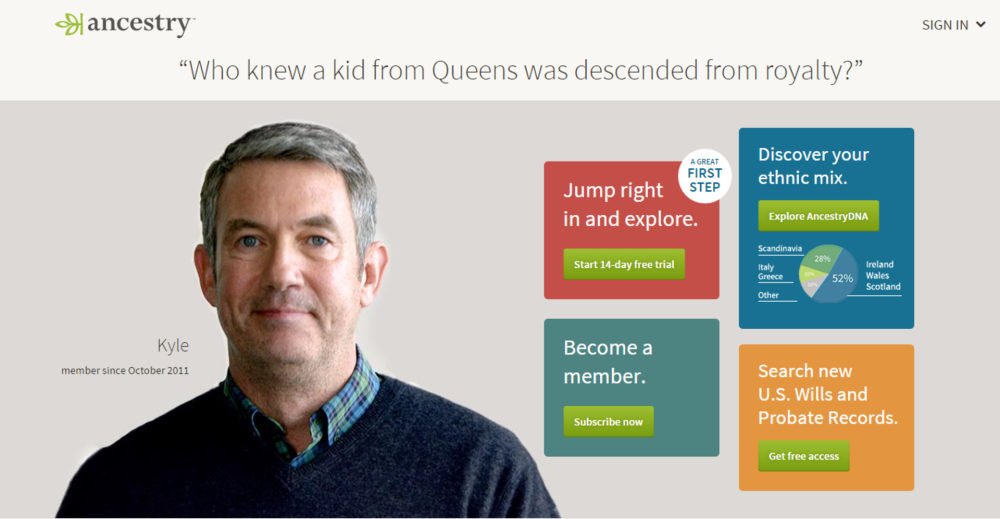At Ancestry we rely heavily on television. As our largest and highest-impact channel, we use TV to generate interest in and consideration of family history, drive traffic to our site, and do it all cost-efficiently and in a small response-time window. This means, the channel must be effective from the very top of the marketing funnel to the very bottom.
In other words: You have 30 seconds. Go.
The creative strategy for our television advertising is paramount, so we never stop researching, innovating and optimizing our approach. When considering our latest television creative strategy, for example, we faced our typical set of challenging objectives:
- Develop an integrated campaign encompassing one emerging product (AncestryDNA) and one mature offering (Ancestry)
- Shift perception of our brand offering from a single, niche product to a brand offering multiple products that are more broadly appealing
- Increase brand awareness
- Increase brand consideration by overcoming key barriers to purchase, such as the perception that discovering your family history requires expert knowledge and is time-consuming
- Significantly increase previous TV acquisition performance metrics
- Meet an aggressive time frame for launch of a new campaign
But these ambitious objectives weren’t the only challenges we faced. Consumer trust is declining globally, even in our traditionally most-trusted category of technology. This shouldn’t come as a surprise. We’ve hit an all-time high in privacy breaches and scandals—scandals that not only affect businesses, but also impact sports, government, doctors, and charities. As a result, consumers are finding it harder and harder to believe what businesses tell them.
So, testimonial television seemed like an idea worth pursuing. After all, we are rich in happy customers with great stories. Ancestry members share fun or meaningful stories with us every day about people like great great grandmothers who were bootleggers or suffragettes, or how they were surprised to find out that they’re actually 32% Irish, not German, after all.
Whoa, wait just a minute. Aren’t TV testimonials those late-night infomercials that leave you feeling even more skeptical or those ads with real people awkwardly reciting a marketing script?
We began to wonder: Could we create TV testimonials that felt right for our warm, authentic brand, drove our brand KPIs, and generated a significant improvement in response—ones that overcame the current environment of consumer skepticism?
Daunting, yes. But, boy, do we love a challenge.
To meet that challenge, we developed the following creative strategy:
- Use real customers. We invited real members to submit their stories to us.
- Require video submission. We asked our members to submit a short video of their story to streamline our recruitment process and increase our chances of success.
- Think like a Boy Scout. We over-prepared and invited five customers to be filmed, even though we planned to use only the three most compelling and authentic testimonials.
- Kill the script. We let our members tell their stories in their own way without putting marketing words into their mouths.
- Show, don‘t tell. While our members told the story of using our products, we showed their actual product experience, including their family trees and ethnicity results.
- Good production quality. Our production quality was neither high-end nor low-end, keeping with the accessibility and authenticity expected of our brand.
Did it work? Yes—and in more ways than we expected.
In our brand tracker, top-line performance results, and A/B testing in-market against our control creative, the testimonial campaign significantly shifted perception of our brand offering, increased consideration among our core audience and our opportunity audiences, and significantly increased visitors to our site at an efficient cost-per-visitor. But we also experienced something less easily measurable: Our members were overjoyed to tell their stories to the world. They found their voice in a way that resonates with our current and prospective customers. We just needed to invite them to testify and get out of the way.
We also learned a few lessons that we’ll take into the extension of the campaign.
- Recruit continuously. Given the success of the campaign, we’ll ask our customers to share their stories with us on an ongoing basis to ensure that we always have compelling customer stories on hand.
- Charisma is king. The more natural charm and presence the customer had, the better the TV spot achieved breakthrough and persuaded customers to visit.
- Integrate other channels. We integrated the customer stories from the TV spot into our other marketing channels, including our key entry pages on our website. The integration delivered a consistent brand message and met or exceeded previous treatments in converting visitors.
- Treat 15-second spots independently. Often 15-second TV spots are simply cut down from a 30-second TV spot. We created 15-second spots independently from the 30-second spots and found them to be more successful.
The bottom line: When it comes to telling your story, nobody does it more believably than your customers. So, let them tell their tales.
About the author:
Kathi Skow is VP of brand marketing at Ancestry where she leads the global brand, product marketing, consumer insights, and creative organizations in marketing a rich portfolio of products. Kathi has 20 years of experience in branding, advertising, and marketing and has helped define and express brands including Adobe, Amazon, Target, and Harley-Davidson.







